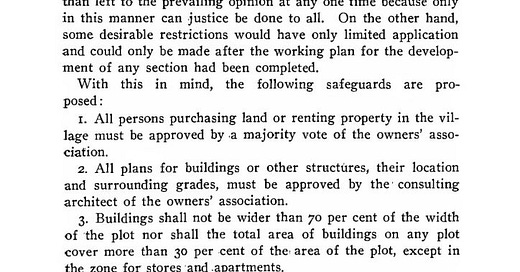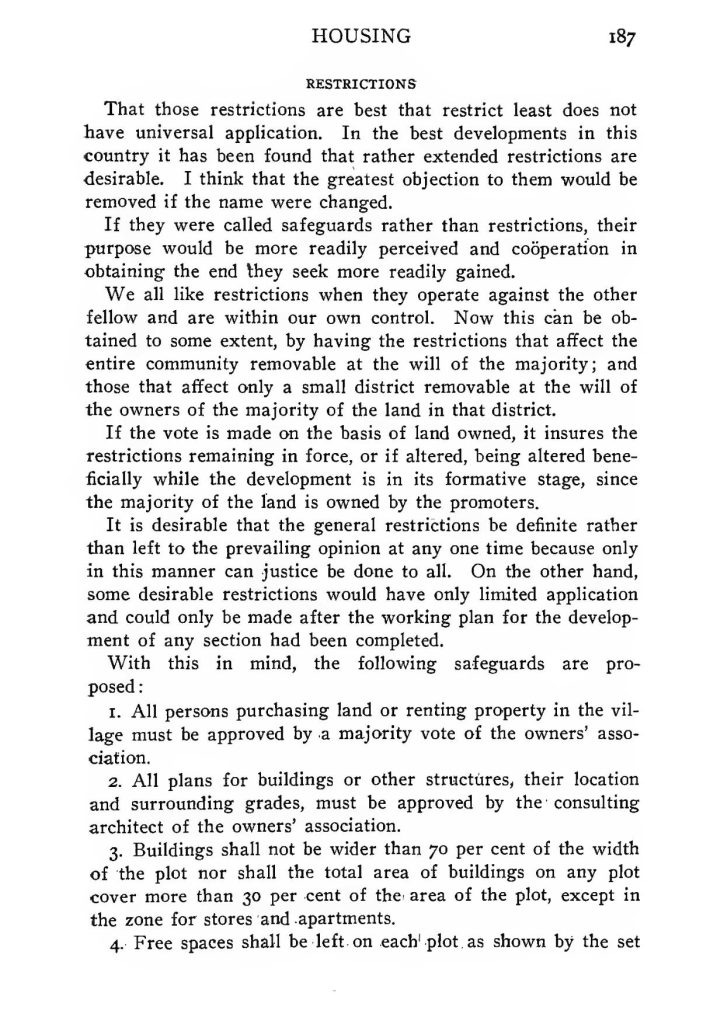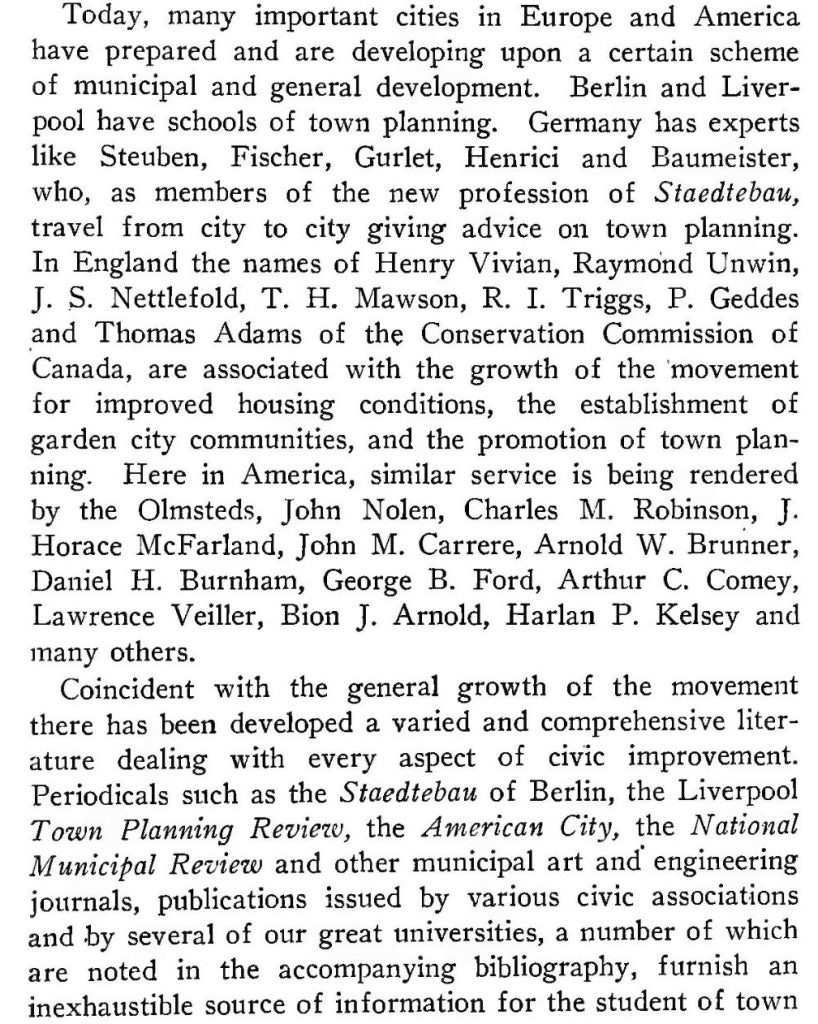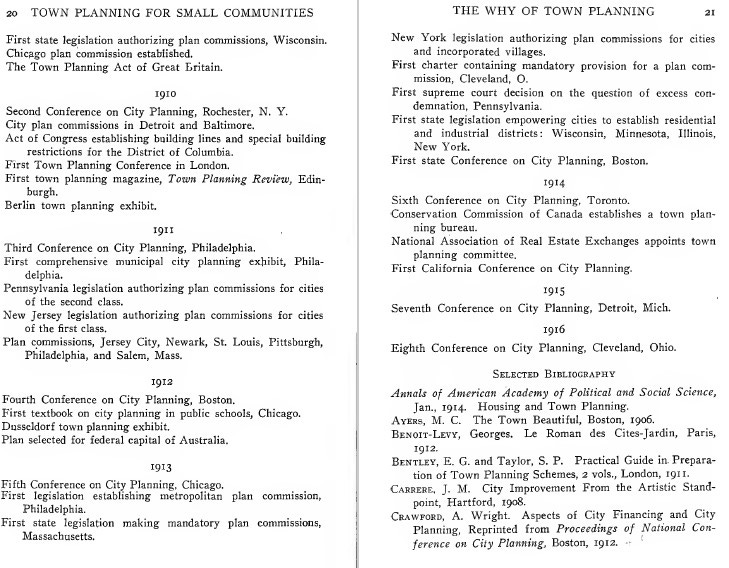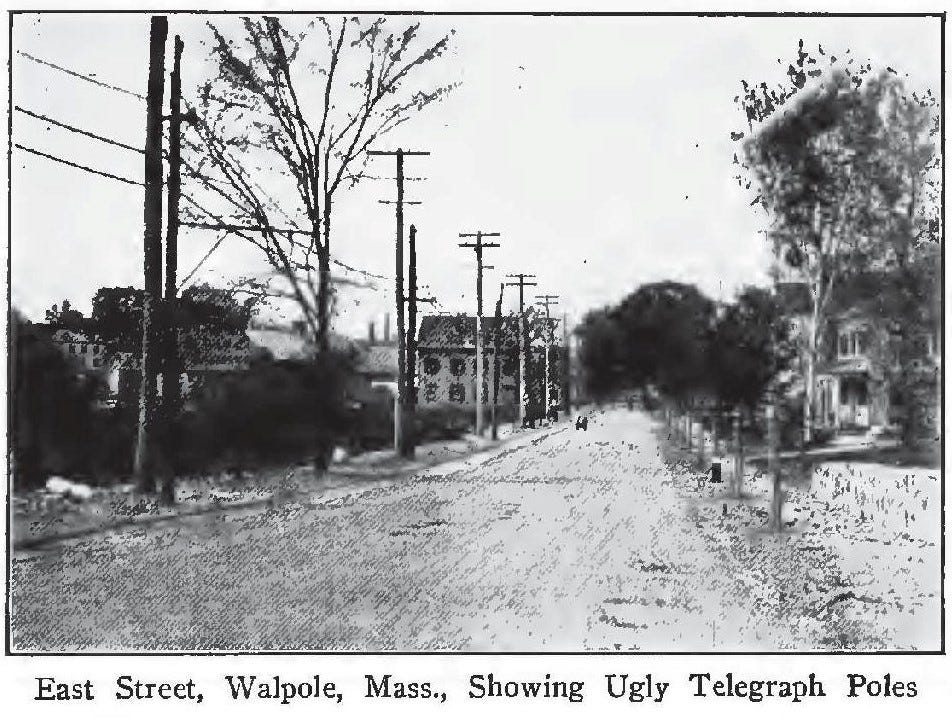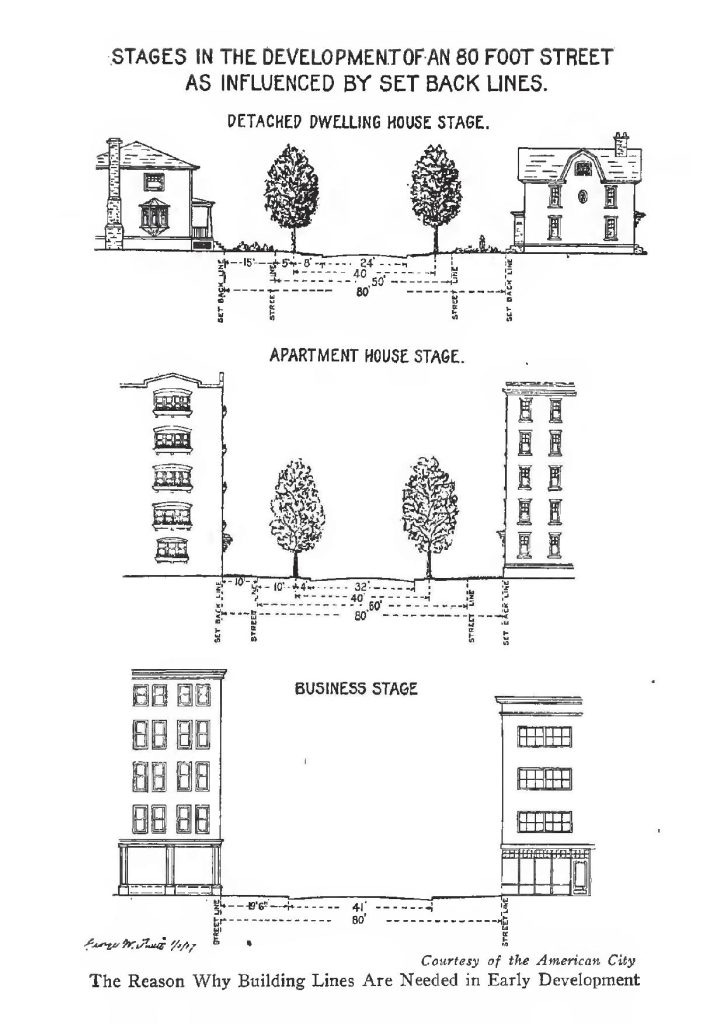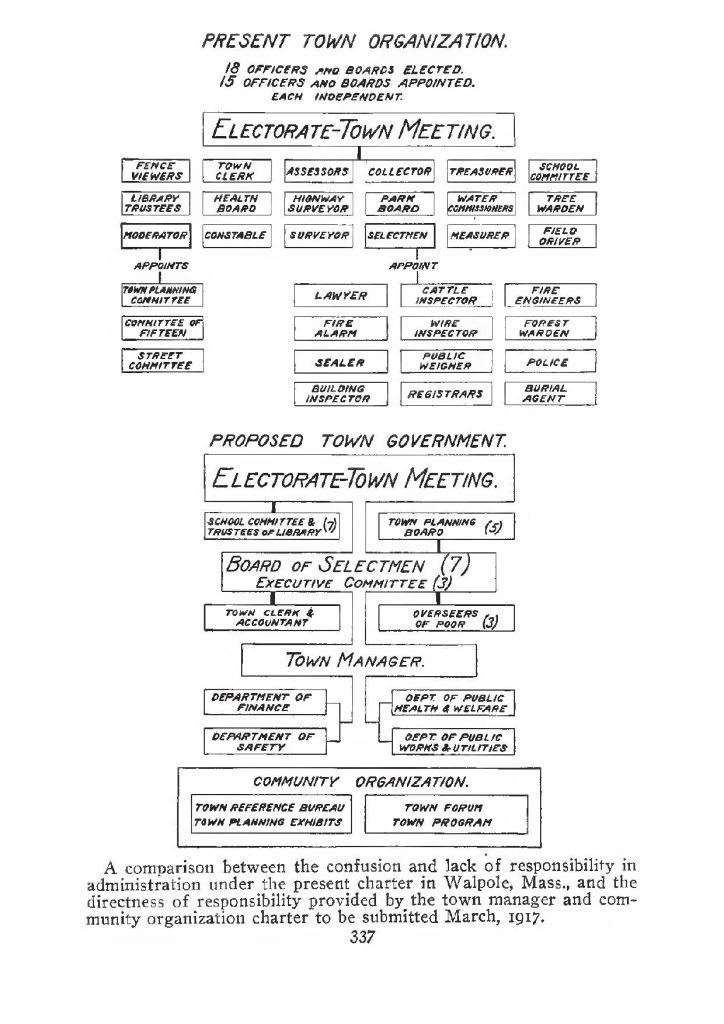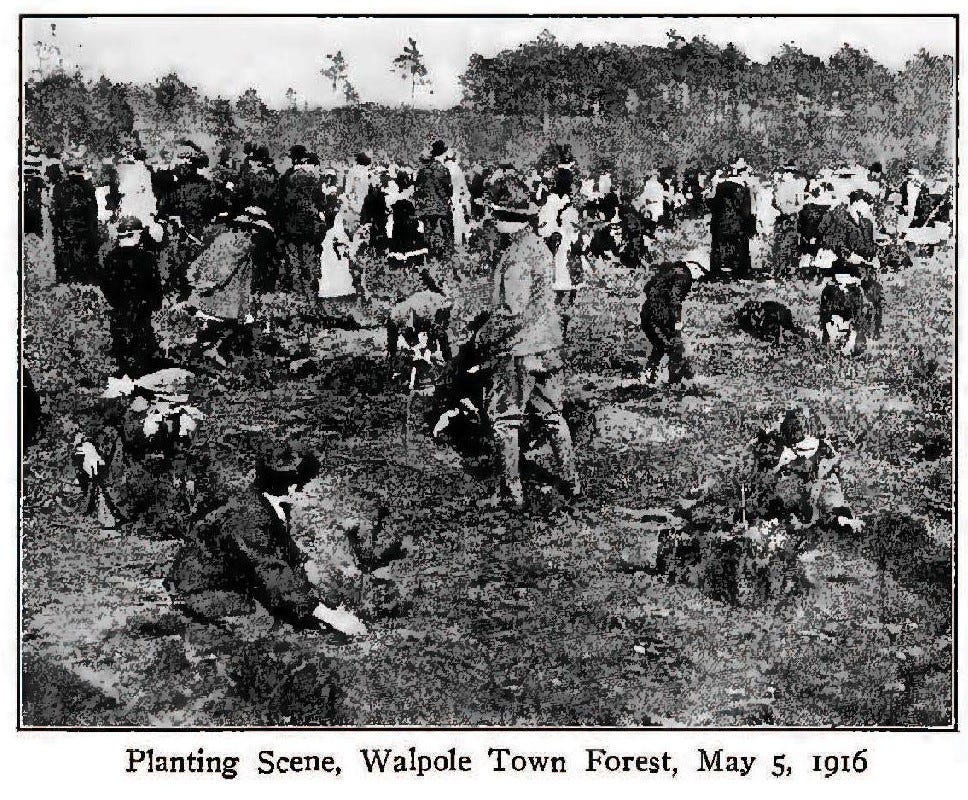1917 Walpole Town and City Planning book
My notes on Germany 1648 to 1806 , Germany 1800 to 1840s , Waikato the golden age 1840s to 1850s , Waikato 1860s , Gentry & Speculators , The beginning of modern planning: Water, Sewage, Housing, Transport, City Centre, Markets and Zoning, 1890s: Introduction, Dwellings & Lots, Reason for Zoning, Horses, Cyclists & road deaths, York, City beautiful & genesis of motorways, Garden City, Dresden 1903, Chicago 1909, 1910s: Hamilton, Columbus, Rochester and Seattle, Newark, Berkeley, Bridgeport,
This book is quite open about its intent; the expert planning consultants wanted to ‘secure funding’ for producing ‘comprehensive town plans’ (Walpole p.48), which included restrictions on the type of people moving into neighbourhoods and the use of the word restrictions (p.211). ‘…they were called safeguards rather than restrictions’ (Walpole p.211) full text in image below.
The purpose of the book was for ‘Walpole citizens to put their house in order; and by thoughtful planning now to make possible the attainment of the highest degrees of economy and efficiency in future growth’ (Walpole p.28). The book’s name is Town Planning for Small Communities, by the Walpole town Planning Committee. Page 28 lists German, English and American experts promoting ‘the new profession of staedtebau’ [urbanism], [who] travel from city to city giving advice on town planning’. John Nolen was one of these experts, and at the end of this post I provide background to his interest in Walpole. ‘Town and city planning means the application of business methods and plain common sense to the management of community affairs ... For any small community a town plan insuring healthy and systematical development is sure to be profitable ... planning exerts a powerful influence in restricting the intensive use of land, an evil to which may be traced the most serious economic problems associated with our growth’ (Walpole p.32). In 1913 the state of Massachusetts had made the ‘establishment of planning boards mandatory for all towns and cities with a population in excess of 10,000’ (Walpole p.42).
‘The first principle of town planning is prevention. It should be the aim of town and city planning administrators to secure funds to prepare a comprehensive plan for town development and acquire such control over undeveloped property’ (Walpole p.48).
There is too much information in this book to summarise; however, it does contain information such as ’at the present time an average of twenty to forty per cent of the total area of cities is devoted to streets’ (Walpole p.72), and opinion on billboards, including – ‘Equally important are measures to control the billboard abuse. There is hardly a city or town in the country that has not been injured in some degree by the billboard nuisance. The smaller communities with large open spaces along their roadways have been particular sufferers through the erection of hideous flaring advertisements. Not only are the billboards ugly in themselves, but they mar the sightlines of all the surrounding property. Real estate values are invariably affected by their presence’ (Walpole p.92).
Planning guidance on HOUSING stated: ‘The ugly, sordid tenement and crowded apartment house, with all the evils of the city slums, which has shown a tendency to develop in many industrial towns unchecked, is a serious menace to the future of this country’ (Walpole p.172). But this book goes further: it is not shy of suggesting reasons for segregation based on character, nationality and wealth – ‘Where houses are built, one close to the other, it is of very great importance that neighbours should have this similarity of tastes and interests. A puritanical family, given to the strict observance of Sunday, does not wish to live next to a German family for whom Sunday is essentially a day of social enjoyment. ... Furthermore, the man who is surrounded by neighbours who are able to live more expensively than he, is apt to become discontented and unhappy. For all of these reasons, the proximity of houses of different classes, instead of creating a feeling of equality, is in danger of creating the reverse and the better-to-do neighbours are apt to either ignore or to patronize the poorer ones’ (Walpole p.208).
APARTMENTS AND STORES - Apartments everywhere are becoming increasingly popular owing to the economy of labour in housekeeping ... Those we have designed for the village are in connection with the stores.
‘A City council is made up of not less than 5 nor more than 25 members, according to the size of the city, elected for a four-year term. Council elects one of its own members as Mayor; appoints a city manager, a clerk, and a civil service board. ... Ten per cent of the total voters at last election are required for referendum petition ‘(Walpole p.354). Council may alter its constitution with a two-thirds General Council majority (Walpole p.381).
Background information on John Nolen and this book, comes from a thesis by Spencer M. Welter on Working for Walpole: The thesis starts with Charles S. Bird Jr’s ambition for a ‘town forest’ (p.3) and ‘English-inspired garden villages’ (p.4, 21-27). For this, ‘the Bird family tasked John Nolen to draw up detailed plans for the Neponset Garden Village’ (p.21), and this led on to ‘The Bird family ... sponsored nearly all of John Nolen's extensive work with the town from 1913-1930’ (p.10). ‘Nolen arrived in Walpole as an established city planner with ambitions to solve nearly every physical problem the growing industrial town had, plans for parks, road realignments, playgrounds, public building positioning, zoning, and the town forest illustrated’ (p.11). ‘As a city planner and architect for nearly four decades, Nolen worked at the forefront of the young American City Planning movement, emphasizing functionality and holistic designs. Robert Freestone summarized that “his mission was to correct the ugliness of the American City while advancing other more fundamental causes of efficiency, mobility, shelter, social justice, and an improved quality of life” (p.12). ‘Summarizing “Anglo Saxons,” Bird explained they demanded all “modern conveniences,” “enjoy having gardens,” and “keep their grounds looking well.” By contrast, the Slavs as a rule are “poor tenants and abuse the property they occupy.” Bird used these generalizations, and others like them, to justify the establishment of four unique zones: ‘the first zone nearest the railroad would host stores and apartments; the second nearest the civic center would be reserved for the “best type of dwelling;” the third zone would be used for less expensive houses; the fourth would be home to miniature farms’ (Welter p.23, Walpole p.175-176 & 184-185).
2017 Working for Walpole: Restorative Spaces in the Progressive Era: bySpencer M. Welter
Town Planning for small communities by Walpole Town Planning Committee. 1917

